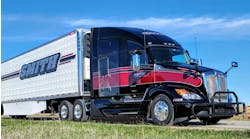Achieving Continuous improvement in preventing workplace accidents requires more than simply creating a safety committee. There needs to be an ongoing emphasis on avoiding risky practices and behaviors. This occurs when a company cultivates a culture of safety.
When done effectively, the result is a safer workplace. This helps protect a company's most valuable resource — its employees — and contributes to significant operational savings.
Refrigerated Transporter's editor-in-chief David A Kolman recently had the opportunity to visit with safety practitioner Chip Dawson to discuss occupational safety. Dawson is retired from Eastman Kodak where he was the safety director at the company's largest plant. He now heads safety consulting for the Rochester (NY) Business Alliance, the regional chamber of commerce.
Question: It's been suggested that a safety committee is critical to success at safety. Do you agree?
Answer: No.
Question: But everyone has safety committees and they are required in some states. Doesn't that make them very important?
Answer: Not really. What is critical to safety is a management that is strongly committed to an injury-free workplace, employees who are involved in the safety process, and everyone with a strong belief in safety as part of the organizational value system. While safety committees can be one way to involve employees, they cannot overcome weak management or the view that safety is all about complying with OSHA.
(The US Department of Labor's Occupational Safety and Health Administration (OSHA) is the main federal agency charged with the enforcement of safety and health legislation.)
Question: Isn't safety a matter of OSHA compliance?
Answer: Not at all. OSHA compliance requires the understanding of many rules designed to ensure a safe physical workplace. It does not address the culture of an organization or the behaviors of its employees.
Question: Can you give an example?
Answer: Take the transportation industry. While DOT controls much of the work that is done on the nation's highways, OSHA has little impact other than in the warehouse. If a company wants drivers to be safe, management must make it clear that certain things are expected and actively support those things.
For example, we know that driving the speed limit is both safer and more fuel efficient, but drivers won't necessarily drive slower unless there are incentives to do so, and management makes it clear that the priority is always safe speeds rather than rushing the load to the customer at all costs.
It's the culture of the company that values responsible and safe driving.
Question: If a company decides to have a safety committee that supports a positive safety culture, how do you suggest it operate?
Answer: Follow these basic guidelines:
-
Don't make the committee responsible for safety. That's management's responsibility.
-
Have senior management actively involved in the committee.
-
Use the committee to advise management and help develop strategy.
-
Use good data to support decisions and track progress.
-
Don't use the committee as an operating tool. Leave operations to the line managers.
-
Give the committee time, funding, and clerical support to do its work.
-
Do not allow committee members to become safety enforcers. That's management's role.
-
Operate the safety committee as other committees are run — as a business function.
-
Have measures of committee success. If it's not working, change or drop the committee.


